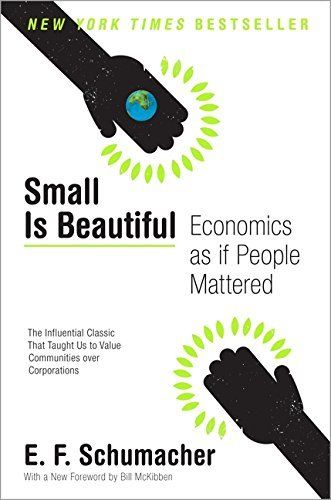An axiological commentary on Schumacher’s Small is Beautifulby RSHI VP Research Clifford G. Hurst, PhD
These similarities provide some degree of face validity to the constructs of formal axiology. And when other authors describe precepts similar to formal axiology in more everyday language than Hartman tended to use, they help me to understand Hartman more easily. I first described this phenomenon in my review of the philosopher Susan Wolfe’s Meaning in Life: And Why it Matters (Journal of Formal Axiology, 2016). Just recently, I discovered remarkable similarities to Hartman’s ideas in the writings of an economist, E.F. Schumacher. I elaborate on those here. In 1973, Schumacher wrote a book that has since become quite famous. It’s named Small is Beautiful: Economics as if People Mattered. Having heard it quoted for years, I finally got around to reading it. Some of what Schumacher says is uncannily similar to Hartman, as indicated by the subtitle, especially to the thoughts expressed by Hartman in his not-yet-published manuscript, Partnership of Capital and Labor. Hartman finished a Partnership of Capital and Labor in 1958, before he ever articulated the theory of formal axiology. In it, he describes three stages in the evolution of capitalism, which sound a lot like a progression from “S” to “E” to “I” valuations of work. The first stage of capitalism, Hartman wrote, is that which treated human labor as unit of production. It was a capitalism heralded by the likes of Frederick Taylor and scientific management. It gave rise to time-and-motion studies, to the assembly line, and in more recent decades, to the practice of statistical process control. It was a form of capitalism against which Karl Marx railed and which still seems to prevail today in efficiency-driven organizations such as Amazon.com. It was a version of capitalism in which any way of reducing labor “costs” yielded a benefit to owners. Capital and labor were, in essence, in competition with each other. This stage one capitalism gave rise to unions and collective bargaining. One side’s loss was another side’s gain. A second stage of capitalism, which Hartman, himself, helped bring into being, was a form of capitalism wherein the worker is recognized, not merely as a highly specialized unit of production, but in his or her role as a contributor to the outcomes of the entire organization. It represented a movement from “S” to “E” valuation of people at work. It reflected a shift in point of view from where labor was seen to be in competition with capital to a setting where labor cooperates with capital. Workers and owners are “in this together.” In this second stage of capitalism, pay and compensation reflect this new form of cooperation. From piece-work pay schemes in stage one capitalism, salaries and profit-sharing become the new norm in stage two. A third stage of capitalism, which was only budding at the time Hartman wrote, goes beyond cooperation to community. Hartman envisioned a working environment wherein labor and capital are truly a community and where workers share not only in the financial rewards of the profit they produce, but where they are recognized as individuals, that is, as whole persons, and not merely for the role they fulfill on the job. Stage three capitalism brings the “I” valuation to the world of work.
As does Hartman, Schumacher embraces the importance of understanding the values that underlie our modes of thought. He writes, “I say, therefore, that we think with or through ideas and that what we call thinking is generally the application of pre-existing ideas to a given situation or set of facts….Some of the ideas are ideas of value, that is to say, we evaluate the situation in the light of our value-ideas.” Schumacher continues, “All traditional philosophy is an attempt to create an orderly system of ideas by which to live and to interpret the world.” The bulk of his book is an attempt to bring to light the limitations imposed on our minds by the taken-for-granted influence of economics on our ways of thinking since the 19th century and is a call to higher orders of thinking. A higher order which, for me, can be found in Hartman’s value theory known as formal axiology. In a very Hartman-like description of the purpose of education, Schumacher writes: “Education can only help us if it produces ‘whole men.’ The truly educated man is not a man who knows a bit of everything…but he will be truly in touch with the centre…The “centre” obviously, is the place where he has to create for himself an orderly system of ideas about himself and the world, which can regulate the direction of his various strivings.” I wonder whether Schumacher knew of Hartman or of his ideas. I have never found reference of one to the other’s work. But, clearly they were in many ways intellectual birds-of-a-feather. I recommend the reading of Schumacher and Hartman side-by-side.
|

 And this is where Schumacher joins the conversation.
And this is where Schumacher joins the conversation.